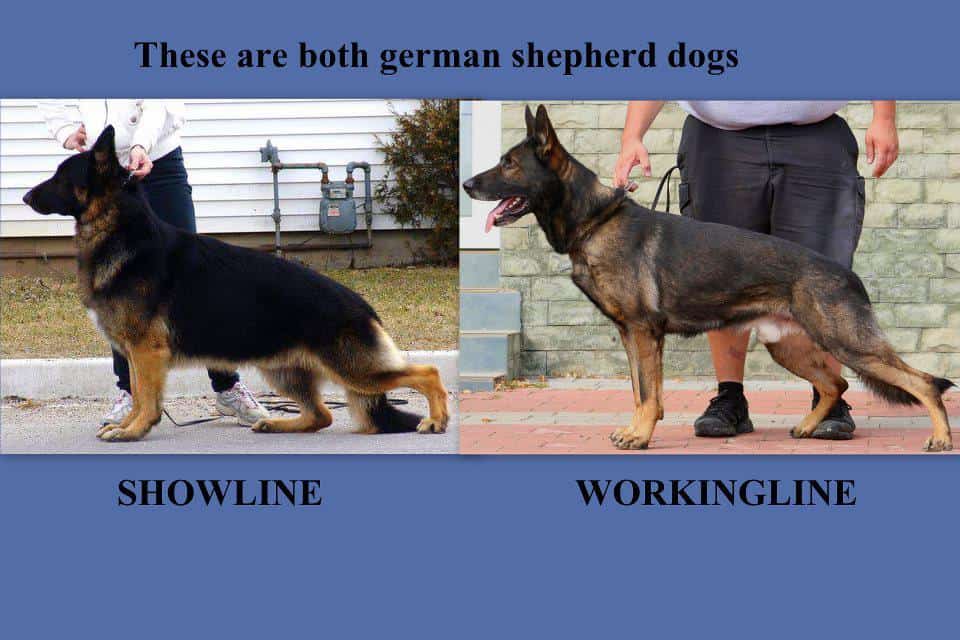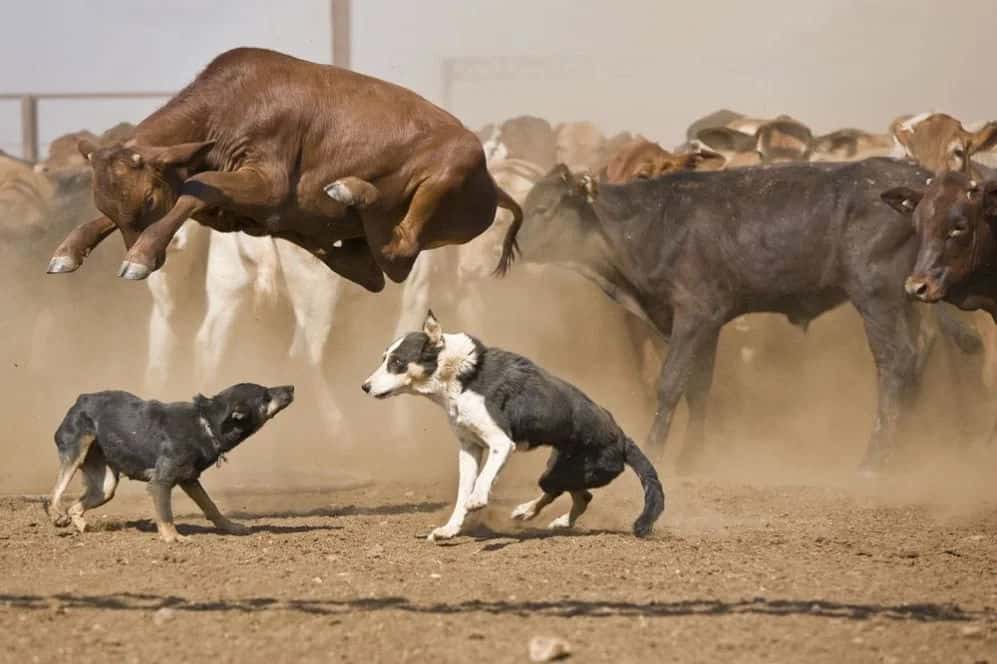We’ve all seen and heard the terms “working dog” and a “show dog” but may not know what exactly separates them. What are the main differences between the two?
Working dogs are typically very active, requiring more physical and mental activity than some pet families can provide. Show dogs are usually less energetic than their working counterparts, usually better looking, often purebred, and sometimes less healthy.
Oftentimes, the fundamental distinction between the two is drive. You can train a show dog to work, but there is a world of difference between a dog that can work and a dog who was specifically bred for the job.
What Makes Working Dogs So Different Than Show Dogs?
Working dogs are never bred to conformation standards, unlike show dogs. Therefore, specific breeding lines determine their size, appearance, and type.
Workers tend to have less coat, but this depends on breeding lines. Many workers have or will ultimately have bulkier coats.
In addition, working dogs have longer bodies and are thinner than square-shaped cobby show-type dogs. Workers are also significantly more intense dogs, with laser-like attention and great work ethics.
Some show breeds are often less healthy. Take, for example, a German Shepherd. The working line of the German shepherd is tougher, healthier, and less prone to hip and elbow dysplasia.
Because of their sloped backs and shorter hind legs, show line GSD is more prone to hip and elbow problems.
The worker line German shepherds have larger, straighter bodies than show lines, which have thinner, slanted backs due to their hind legs being shorter than their front legs.

Show line dogs are often less healthy. The picture above shows a bone structure defect that can be extremely unpleasant for the dog. It makes walking uncomfortable and can cause arthritis concerns as the dog ages, making walking much more difficult.
What Makes a Dog a Working Dog?
Working dogs are bright, powerful, attentive, alert, and learn quickly. They were bred to help humans and excel at activities including guarding property, herding sheep, hauling sleds, and performing rescues.
A working dog is one of two things:
- A dog breed that is classified as a working group by the ACK or another National Kennel Club.
- A dog that has been taught a specific task unrelated to sports, such as detection, apprehension, disability tasks, and hunting.
Typically, a “working dog” is used in the dog community to describe a dog performing well rather than looking good.
Working sheepdogs, for example, need breeders to prioritize intelligence over all other characteristics. It makes no difference what color a dog is if it can do its job and herd the sheep. A dog that is nearly all black will work just as well as a tricolor or merle dog.
A working dog will have the functional attributes required for the job. A working Labrador, for example, will have more energy, be leaner, have a sharper mind, and be kept outside in a kennel.
They’ll have a lot more energy that, if not used, will usually result in a frustrated and bored Labrador. This might lead to undesirable behaviors such as furniture chewing and irritability. Herding children is typical in some breeds, especially if they get bored.
It’s worth noting that not every dog within a working breed will have the temperament or skills for professional tasks. Similarly, not all pet dogs lack the capability to work, but the breeding intent often sets the foundational differences.

Main Types of Working Dogs
We can distinguish nine main types of working dogs:
- Therapy dog (provides companionship or helps people rehabilitate from injuries)
- Service dog (trained to help a disabled person in some way)
- Herding dog (trained in herding livestock)
- Guard dog, used to protect buildings or livestock.
- Drafting (pulling, sled) dog. Traditionally used to pull dog carts or sleds.
- Detection (sniffer) dogs are trained to detect substances such as explosives, illegal drugs, wildlife scat, currency, blood, and contraband electronics.
- Guide dog (trained to lead blind or visually impaired people around obstacles)
- Military working dogs trained in combat or used as scouts, sentries, messengers, mercy dogs, and trackers.
- Search and rescue dog (trained to find missing people)
Many different breeds can do these jobs. Siberian Huskies, Great Danes, and Doberman Pinschers are part of this Group, to name a few. Although, Dobermans aren’t the first pick for police work.

What Qualifies a Dog to Be a Show Dog?
A show dog is a dog that has been specially bred, trained, and/or groomed to meet the requirements of dog shows to compete.
There are several dog shows, such as a Fun Show, Test and Trial, and a Conformation Show. Each requires various training levels, while some require none, such as the case with Fun Shows.
In the kennel club handbook for a specific breed, show dogs will have the best qualities listed for that breed. This does not necessarily imply that they are healthy. However, these dogs will receive royal treatment, frequent grooming, and comfortable beds. They’ll be inside most of the time.
The breeder’s integrity also determines the appearance of the show dog and whether they are breeding for money or for the betterment of the breed. While working dogs are honed for function, sometimes at the cost of aesthetic appeal, show dogs often become the poster children for a breed’s idealized standard.
A show dog can be exceptionally fit or trained in the work for which the dog was initially bred.
Breeders select calmer temperaments to excel in the show ring. It makes them better companions and family pets than herding dogs of the same breed. Unlike a show dog, the herding dog is bred to have a lot of energy and a strong working drive.
Do Working Dogs Make Good Pets?
Many breeds are considered “working breeds,” yet with the correct physical and mental stimulation, they may make fantastic pets, which most dogs are.
Even working dogs can live in homes with families, but remember that mental activity wears you out more than physical activity. Working dogs can thrive in the pet home of an experienced owner ready to devote time and resources.
In many ways, these dogs are working dogs first and pets second, especially if you have a stock line version of these dogs rather than a show line. However, regular people can mimic the enrichment and demands on their bodies and minds that these dogs need.
So what’s the difference between a working dog and a pet dog? Interestingly, the distinction between working dogs and pets often boils down to the intensity of their drive; a pet dog might be content with a daily walk, while a working dog craves a challenge to satiate its innate drive.
While many believe the line between working and pet dogs is rigid, there’s often a spectrum, with some working dogs transitioning beautifully into family lives when given the right balance of mental and physical stimulation.
Not all herding dogs have the instinct, drive, or ability to be properly trained to work cattle and sheep. Not all sled dogs have the necessary drive or physicality to pull a sled.
As a result, many of these dogs are bred solely for confirmation, making them less energetic and more ideal for pet homes.
Do Show Dogs Have to Be Purebred?
Whether the dog needs to be purebred depends on the show type.
Conformation dog shows are only for registered purebred dogs. They have recently permitted various mixed breeds in sporting classes such as herding, rally, dock diving, etc. Obedience and agility competitions are open to mixed breeds.
However, some criteria on different shows will attract owners of only purebred dogs. According to AKC conformation requirements, dogs need to be a recognized breed by the AKC, to be registered, not spayed/neutered, and healthy with no disqualifying faults.
Fun Shows and Tests and Trials shows aren’t that strict about the purebred factor (if at all). For some, only appearance and training are what matter.
Generally, appearance standards are truly only important for dog shows. Herd dog shows, for example, don’t always care if a dog is “purebred.” The important thing is whether it can muster the sheep accurately and on demand.
On the other hand, when considering a show dog, breed purity often becomes paramount, ensuring that the dog showcases the breed’s finest characteristics, even if it doesn’t have a working task in its daily life.
FAQs
What’s the hardest working dog?
The German Shepherd, Labrador Retriever, Golden Retriever, Border Collie, Belgian Malinois, Siberian Husky, Bloodhound, and Bull Terrier are among the breeds of dogs that work the hardest. The effort required, training, and personality of the dog all influence whether it is “hard-working.”
How much is a show dog worth?
Depending on the breed and reputation, a purebred dog can range from $1,000 to $5,000. Some breeds are less popular, and you might be able to get a dog for $500, but it may not have the pedigree. You could still show the dog.
Can you touch or pet a working dog?
It depends on the working dog. You should never approach and pet a working dog without permission, especially a police dog, as you could end up in a dangerous scenario. Always ask the person first, be courteous, and listen to their directions.
Alex, a passionate animal lover, has experience in training and understanding animal behavior. As a proud pet parent to two dogs and three cats, he founded AnimalReport.net to share insights from animal experts and expand his knowledge of the animal kingdom.




